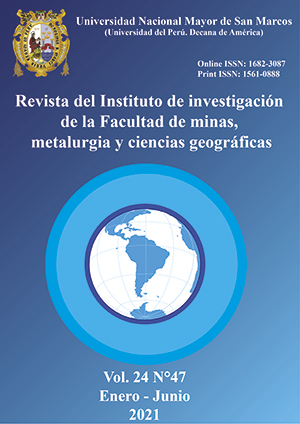Dynamic support design to mitigate rock burst
DOI:
https://doi.org/10.15381/iigeo.v24i47.20646Keywords:
Rock burst, dynamic support, dynamic boltAbstract
In more than 100 years of underground mining, the mine has deepened, making larger openings by mechanization, changing the natural conditions of the rock mass, creating energy release problems known as rock bursting.
The research methodology is quantitative, descriptive and explicatory. By applying observation techniques, the deformation of rocks was seen, classification and laboratory tests of rock mechanics, behavior of seismic waves and others were made, determining the dynamic properties of the rocks. The results indicate that the probability of rock bursting is weak to moderate, the strength of the intact rock is in the range of 92.5 to 163.7 MPa, the squeezing will be light to moderate and others. The support in most mines is static. Static support reaches a deformation of up to 16% for every 200.0 mm of length with a maximum energy absorption of 3 KN / m2, while dynamic support has a deformation greater than 600 mm with an energy absorption of up to 40 KN / m2. for this reason, it is shown that this is the best alternative to support for mining.
Downloads
Published
Issue
Section
License
Copyright (c) 2021 Elvis William Valencia Chávez, Enrique Guadalupe Gómez

This work is licensed under a Creative Commons Attribution 4.0 International License.
AUTHORS RETAIN THEIR RIGHTS:
a. Authors retain their trade mark rights and patent, and also on any process or procedure described in the article.
b. Authors retain their right to share, copy, distribute, perform and publicly communicate their article (eg, to place their article in an institutional repository or publish it in a book), with an acknowledgment of its initial publication in the Rev. Inst. investig. Fac. minas metal cienc. geogr.
c. Authors retain theirs right to make a subsequent publication of their work, to use the article or any part thereof (eg a compilation of his papers, lecture notes, thesis, or a book), always indicating the source of publication (the originator of the work, journal, volume, number and date).






